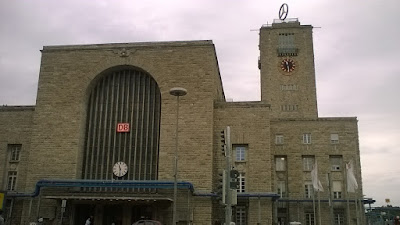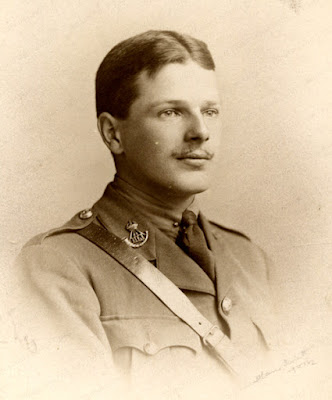Strange but true: whenever I see a German Christmas market, something deep and Teutonic within me forces me to visit each and every stall, sniffing the gingerbread with relish, admiring the green and red decorations and the twinkly lights, and risking frostbite in the cold north east air to nibble on wurst mit brod and sip a cup of gluhwein. So there was no way I was going to miss a genuine German farmers’ market.
But it was to be the Day of Pigs.
By way of explanation, when Carol visited Germany two years ago for the first reunion, she liberated the very lovely Sir Oinks-a-Lot, a fluffy Hohenlohe-type toy pig. Sir Oinks-a-Lot had very positive vibes about the north east, so made his way by post to our Mother’s house where he lives a life of luxury, munching on windfall apples, and sampling her collection of Baden-Wurttenburg wines.
 |
| Sirs Scratch-a-lot and Scoff-a-lot enjoyed the Black Forest Gateau, photo by Carol and Andrea |
Poor saps that we are, we had no way of knowing that a ‘net-pork’ had built up, and that Sir Oinks-a-Lot had alerted his nephews to the delights of life in the UK. So we were adopted without any consultation whatsoever by Sir Scoff-a-Lot and Sir Scratch-a-Lot, also Hohenlohe pigs. In the manner of escapees wishing to avoid being eaten and to embrace a better life, they were only too keen to follow us piggedly. Carol and I were of course already alerted to the comfort and importance of having family ties in a foreign land, however tenuous those ties might be in reality, and it is a fact that the Hohenlohe schwein is a close cousin of the English Saddleback pig. The Black Forest gateau we bought as a treat for ourselves proved too tempting for them. They were thrilled to be offered a drink of Lowenbrau beer by Richard, a passing friend of ours.
Moving swiftly on…which we did, to Langenburg Castle the following day, the magnificent palace of the current Prince of Hohenlohe-Langenburg. And lucky them, as the building is beautiful with one of the finest interiors. There is a small but perfect chapel with script and drawings from the Old and New Testament and a gorgeous painted ceiling. After coffee und cake in the café, we continued our ‘Princesses for the Day’ tour by visiting their summer palace. It is another beautiful, though smaller, home, now owned by a farming family who are gradually restoring and adding to the existing buildings.
We then enjoyed a wine tasting with a twist: the wine was only 2% or so, but tasted deliciously of the flowers used. We drank elderflower, rose and meadowsweet, all of which were faithful to the scent of each type of flower. The schnapps was much stronger in taste and alcohol, and we had a slightly blurry ride back to Ilshofen for our final night of food and entertainment.
Our final dinner at the hotel was sublime, but everyone was feeling a little sentimental as it was our last night as a group. Karl-Heinz Wüstner gave an excellent presentation about our pork butcher forebears, explaining the circumstances in which they left the Hohenlohe region, mostly at very young ages, and took up butchery apprentices.
I realised that far from being a solid English Rose, I am in fact a third-generation economic migrant. My history is a place where the mother tongue, German, was spoken at home, and where it seemed preferable to find a husband or wife with the same background. Many young girls travelled to the UK from Germany and secured positions as domestic staff to well off families, subsequently marrying the trained pork butchers. Our relatives chose to marry outside the comfort zone of others from the Hohenlohe region - did this make them bold entrepreneurs, seekers of a better life for their families? Or cheeky and sly newcomers who relied on charm and good looks to worm their way into a new society? Either way, they joined a revolution that was precipitated by the Industrial Revolution: the need for cheap, available food on the hoof; very appropriate for people from an area where the Hohenlohe pork is so valued. It was an improvement on carrying bread and cheese to work, a bread roll with a sausage for lunch, hot and tasty, cheap, and sufficient to carry you through to the end of the backbreaking working day. Fast food German style.
 |
| Frieda, Theodor Jr, and Caroline Fiedler, Theo Fieldler's children, from Carol Hunt's family collection |
The two world wars impacted on the families who were still finding their feet in a new land. Carol and I had been told by our mother about people hurrying their children past the house, ‘because Germans live there’. Other pork butcher descendants were spat on, and our great-grandfather Theo was only one of the immigrant butchers who were interned on the Isle of Man and then exchanged by the German Red Cross for an English prisoner of war. Many others had spent time in Germany during and after the First World War missing their wives and children and the life they had forged in their adopted homeland. During the Second World War, Theo was subjected to the indignity of being compelled to register with the police after he had returned to the UK. He was over 70 and no threat to anyone, but despite his evident love for his English wife, his children and his adopted home, he was treated as a threat to national security.
In an interesting aside to this story, our paternal Granddad, Charlie, who fought for the British at Ypres in the First World War, never had any time for our mother as she came from a German family. His motto was, ‘the only good German’s a dead German’. One of his drinking pals turned out to be the policeman to whom Theo reported week after week. He told Granddad Charlie that Theo was the nicest man you could meet; an all-round good egg, following which Charlie decided that not all Germans deserved to die, a seismic shift for a First World War veteran.
During our time in Hohenlohe we met many lovely people. Some were German, some were English, but there were also Scots, Irish, and Welsh. Everyone entered into the spirit of adventure, we all wanted to hear each other’s stories and learn something new. Everyone was aware of the importance of travelling hopefully over arriving.
The next morning, we were set to leave the group at Schwabisch Hall station. The medieval city of Schwabisch Hall was one of our father's favourite places, and it is easy to see why. We enjoyed our walking tour, the famous steps of the Protestant church, the wear across the river Kocher. We were able to marvel at seven storey medieval buildings, canals cut into the fronts of buildings to provide easy access to transport, and a modern reproduction of the Globe theatre, decorated with Shakespeare's lines in English and German. Although the story of salt is pivotal to understanding the history of the town, its beauty made it difficult to focus on anything else.
 |
| All the World's a Stage, The Globe Theatre, Schawbisch Hall, photo by Carol and Andrea |
At the Schwabisch Hall museum they had a Picasso exhibition with his paintings displayed against complementary works. There were works by Max Beckmann and Otto Dix, commenting on the Third Reich which made for uncomfortable and thought-provoking contemplation.
Our father joined the RAF at the start of the Second World War, and successfully trained to become a navigator. He had absolutely no sense of direction, as a child I used to ask him how on earth he could navigate such a sophisticated piece of machinery, and he said he simply told the pilot, 'follow that plane', as they flew in strict formation. He was involved in the programme of bombing that Winston Churchill and Arthur 'Bomber' Harris determined, although he refused to talk about it. However, he travelled widely in Germany in the 1970s and loved the country and the people. He willingly did his duty to his nation, but his feelings about what he did in the war were at best ambivalent.
We walked back to the coach rendezvous following the course of the Kocher. Our great-great Aunts were known as 'Kocher Queens' as they swam in the river at Kunzelsau every day. Neither Carol nor I were tempted to recreate their feats as the cloudy green water did not look welcoming.
I was sad to leave Schwabisch Hall. Leaving marked the beginning of the end of our holiday, and we said goodbye to the majority of our pork butcher descendant peers. But we had the journey still ahead of us, another night in Stuttgart to look forward to, and two porcine passengers to look after.








